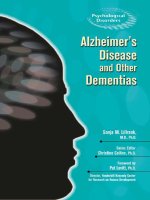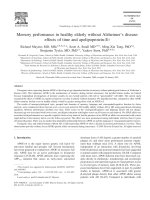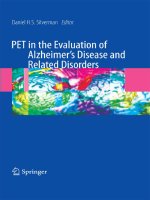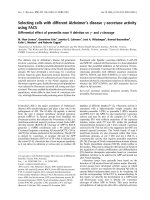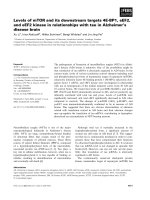ALZHEIMER’S DISEASE PATHOGENESIS-CORE CONCEPTS, SHIFTING PARADIGMS AND THERAPEUTIC TARGETS pot
Bạn đang xem bản rút gọn của tài liệu. Xem và tải ngay bản đầy đủ của tài liệu tại đây (34.69 MB, 702 trang )
ALZHEIMER’S DISEASE
PATHOGENESIS-CORE
CONCEPTS, SHIFTING
PARADIGMS AND
THERAPEUTIC TARGETS
Edited by Suzanne De La Monte
Alzheimer’s Disease Pathogenesis-Core Concepts, Shifting Paradigms and
Therapeutic Targets
Edited by Suzanne De La Monte
Published by InTech
Janeza Trdine 9, 51000 Rijeka, Croatia
Copyright © 2011 InTech
All chapters are Open Access articles distributed under the Creative Commons
Non Commercial Share Alike Attribution 3.0 license, which permits to copy,
distribute, transmit, and adapt the work in any medium, so long as the original
work is properly cited. After this work has been published by InTech, authors
have the right to republish it, in whole or part, in any publication of which they
are the author, and to make other personal use of the work. Any republication,
referencing or personal use of the work must explicitly identify the original source.
Statements and opinions expressed in the chapters are these of the individual contributors
and not necessarily those of the editors or publisher. No responsibility is accepted
for the accuracy of information contained in the published articles. The publisher
assumes no responsibility for any damage or injury to persons or property arising out
of the use of any materials, instructions, methods or ideas contained in the book.
Publishing Process Manager Petra Zobic
Technical Editor Teodora Smiljanic
Cover Designer Jan Hyrat
Image Copyright Carsten Erler, 2010. Used under license from Shutterstock.com
First published August, 2011
Printed in Croatia
A free online edition of this book is available at www.intechopen.com
Additional hard copies can be obtained from
Alzheimer’s Disease Pathogenesis-Core Concepts, Shifting Paradigms and
Therapeutic Targets, Edited by Suzanne De La Monte
p. cm.
978-953-307-690-4
free online editions of InTech
Books and Journals can be found at
www.intechopen.com
Contents
Preface XI
Part 1 Overview 1
Chapter 1 Alzheimer´s Disease
– The New Actors of an Old Drama 3
Mario Álvarez Sánchez, Carlos A. Sánchez Catasús,
Ivonne Pedroso Ibañez, Maria L. Bringas and
Arnoldo Padrón Sánchez
Chapter 2 Pathophysiology of Late Onset Alzheimer Disease 21
Ahmet Turan Isik and M. Refik Mas
Part 2 Amyloid and Tau Mediated
Neurotoxicity and Neurodegeneration 29
Chapter 3 Expression and Cerebral Function of Amyloid
Precursor Protein After Rat Traumatic Brain Injury 31
Tatsuki Itoh, Motohiro Imano,
Shozo Nishida, Masahiro Tsubaki,
Shigeo Hashimoto, Akihiko Ito and Takao Satou
Chapter 4 Key Enzymes and Proteins in
Amyloid-Beta Production and Clearance 53
Cecília R A Santos, Isabel Cardoso and
Isabel Gonçalves
Chapter 5 Transporters in the Blood-Brain Barrier 87
Masaki Ueno, Toshitaka Nakagawa and
Haruhiko Sakamoto
Chapter 6 Contribution of Multivesicular Bodies
to the Prion-Like Propagation
of Lesions in Alzheimer’s Disease 107
Valérie Vingtdeux, Luc Buée and Nicolas Sergeant
VI Contents
Chapter 7 Pathological Stages of Abnormally
Processed Tau Protein During Its Aggregation
into Fibrillary Structures in Alzheimer’s Disease 131
Francisco García-Sierra, Gustavo Basurto-Islas,
Jaime Jarero-Basulto, Hugo C. Monroy-Ramírez,
Francisco M. Torres Cruz, Hernán Cortés Callejas,
Héctor M. Camarillo Rojas, Zdena Kristofikova,
Daniela Ripova, José Luna-Muñoz, Raúl Mena,
Lester I. Binder and Siddhartha Mondragón-Rodríguez
Chapter 8 Structure and Toxicity of the Prefibrillar Aggregation
States of Beta Peptides in Alzheimer’s Disease 151
Angelo Perico, Denise Galante and Cristina D’Arrigo
Chapter 9 Structural and Toxic Properties of
Protein Aggregates: Towards a Molecular
Understanding of Alzheimer's Disease 173
Lei Wang and Silvia Campioni
Part 3 Abnormalities in Signal Trandusction,
Neurotransmission, and Gene Regulation 195
Chapter 10 The Role of Glycogen Synthase
Kinase-3 (GSK-3) in Alzheimer’s Disease 197
Miguel Medina and Jesús Avila
Chapter 11 Pin1: A New Enzyme Pivotal for
Protecting Against Alzheimer’s Disease 223
Kazuhiro Nakamura, Suk Ling Ma and Kun Ping Lu
Chapter 12 Selectivity of Cell Signaling in the Neuronal Response
Based on NGF Mutations and Peptidomimetics in the
Treatment of Alzheimers Disease 243
Kenneth E. Neet, Sidharth Mahapatra, Hrishikesh M. Mehta
Chapter 13 Advances in MicroRNAs and
Alzheimer’s Disease Research 273
Francesca Ruberti, Silvia Pezzola and Christian Barbato
Part 4 Oxidative Stress, Reactive
Oxygen Species and Heavy Metals 295
Chapter 14 Role of Mitochondria in Alzheimer´s Disease 297
Genaro Genaro Gabriel Ortiz, Fermín Pacheco-Moisés,
José de Jesús García-Trejo, Roció E. González-Castañeda,
Miguel A. Macías-Islas, José A. Cruz-Ramos,
Irma E. Velázquez-Brizuela, Elva D. Árias Merino and
Alfredo Célis de la Rosa
Contents VII
Chapter 15 Oxidative Stress in Alzheimer’s Disease:
Pathogenesis, Biomarkers and Therapy 319
Alejandro Gella and Irene Bolea
Chapter 16 Impact of Oxidative - Nitrosative Stress
on Cholinergic Presynaptic Function 345
Stefanie A.G. Black and R. Jane Rylett
Chapter 17 Metals Involvement in
Alzheimer’s Disease Pathogenesis 369
Rosanna Squitti and Carlo Salustri
Chapter 18 Alzheimer’s Disease and Metal
Contamination: Aspects on Genotoxicity 403
P.D.L. Lima, M.C. Vasconcellos, R.C. Montenegro and R.R. Burbano
Part 5 Metabolic Derangements:
Glucose, Insulin, and Diabetes 435
Chapter 19 Glucose Metabolism and Insulin
Action in Alzheimer’s Disease Pathogenesis 437
Domenico Bosco, Massimiliano Plastino,
Antonio Spanò, Caterina Ermio and Antonietta Fava
Chapter 20 Insulin Resistance, Cognitive
Impairment and Neurodegeneration:
Roles of Nitrosamine Exposure, Diet and Lifestyles 459
Suzanne de la Monte, Ming Tong and Jack R. Wands
Chapter 21 The Relations Between the
Vitamins and Alzheimer Dementia 497
Emel Koseoglu
Part 6 Additional and Novel Concepts 519
Chapter 22 Hypotension in Subcortical Vascular Dementia,
a New Risk Factor – Wasn’t It Hypertension? 521
Rita Moretti, Francesca Esposito,
Paola Torre, Rodolfo M. Antonello and Giuseppe Bellini
Chapter 23 Autophagy-Derived Alzheimer’s Pathogenesis 539
Daijun Ling and Paul M. Salvaterra
Chapter 24 Plasmalogen Deficit: A New and Testable
Hypothesis for the Etiology of Alzheimer’s Disease 561
Paul L. Wood, M. Amin Khan,
Rishikesh Mankidy, Tara Smith and Dayan B. Goodenowe
VIII Contents
Chapter 25 Gangliosides as a Double-Edged
Swordin Neurodegenerative Disease 589
Akio Sekigawa, Masayo Fujita, Kazunari Sekiyama,
Yoshiki Takamatsu, Jianshe Wei and Makoto Hashimoto
Chapter 26 Structure Based 3D-QSAR
Studies on Cholinesterase Inhibitors 603
Zaheer ul Haq and Reaz Uddin
Part 7 Potential Therapeutic Strategies 633
Chapter 27 Tau Oligomers as Potential Drug
Target for Alzheimer Disease (AD) Treatment 635
Rakez Kayed
Chapter 28 In Silico Design of Preventive
Drugs for Alzheimer’s Disease 647
Arpita Yadav and Minakshi Sonker
Chapter 29 Protective Roles of the Incretin Hormones Glucagon-Like
Peptide-1 and Glucose-Dependent Insolinotropic
Polypeptide Hormones in Neurodegeneration 669
Christian Hölscher
Preface
Alzheimer’s disease is the most common cause of dementia in modern industrialized
and high technology-driven cultures, and it is rapidly spreading to poorer nations
throughout the world. For years, research on Alzheimer’s was focused on gene
mutations and polymorphisms in large kindred or selected populations. Those studies
championed the roles of either, amyloid deposition and neurotoxicity, or intra-
neuronal accumulations of abnormally phosphorylated tau as the principal mediators
of neurodegeneration. For some time, only two major camps were recognized: one for
the “Tau-ists”, and the other for the “β-APP-tists”. Soldiers in each camp vigorously
defended their own turf, and every square-inch of newly gained ground, fighting off
all major as well as minor threats. Such divisive approaches ended up being counter-
productive. Eventually, a cease fire was called, and a new era of collaboration and
exchange arrived. Fortunately, even during those intellectually lean years, new and
distinct concepts about the pathogenesis of Alzheimer’s disease began to emerge and
gain steam. To some extent, the flourishing of alternative concepts, including the roles
of oxidative stress, mitochondrial dysfunction, metal toxicities, cerebrovascular
disease, and immune/inflammatory responses as mediators of neurodegeneration, was
inspired by the facts that: 1) the most important risk factor for developing Alzheimer’s
is aging; and 2) over 90% of Alzheimer cases exhibit sporadic rather than familial
occurrences. More recently, interest in the contributions of diabetes mellitus, obesity
and insulin resistance as causal or contributing factors in the pathogenesis of
Alzheimer’s disease has grown considerably. Although much of the current research
is still heavily focused on the direct and indirect roles of amyloid- and phosphorylated
tau-mediated neurotoxicity and neurodegeneration, the field has broadened and the
paradigm depicting the path toward Alzheimer’s has shifted to accommodate newer
and more diverse concepts. This book, “Alzheimer’s Disease Pathogenesis: Core
Concepts, Shifting Paradigms, and Therapeutic Targets” is an exciting work because
the collection of chapters provides insight into the full range of concepts that are now
under serious consideration with regard to the pathogenesis of Alzheimer’s disease.
This book is unusual in that it provides current information within each of the sub-
disciplines, and therefore will satisfy the needs and interests of both newcomers to the
field, and specialized experts interested in understanding concepts and approaches to
Alzheimer’s that are distinct from their own.
XII Preface
The Overview section contains two chapters that summarize and review the standard
features of Alzheimer’s pathology, epidemiology, genetics, and pathophysiology. This
is an excellent section for reviewing the basics and the basis for which therapeutic and
diagnostic approaches have already been developed and are currently under
investigation. The second section, “Amyloid and Tau Mediated Neurotoxicity and
Neurodegeneration” provides a well-balanced series of 7 chapters that explain how
amyloid deposits and fibrils are generated from amyloid precursor protein, including
the enzymes, biochemical, and molecular mediators of the process, the pathogenesis of
Tau pathology, and how oligomers of both amyloid and tau fibrils contribute to the
pathogenesis and progression of Alzheimer’s disease. The first two chapters in this
section provide excellent accounts of the expression and function amyloid precursor
protein (APP) and the processing and cleavage of APP to amyloid beta. The authors
explain the biochemical and pathological mechanisms that drive amyloid beta
accumulation in Alzheimer’s. Dr. Santos provides a very clear and informative
discussion of how amyloid precursor protein is processed, and current concepts
concerning the mechanisms by which amyloid-beta accumulates in plaques, fibrils,
and oligomers. The chapter by Dr. Ueno extends these concepts, providing a thorough
and highly topical account of the structure and function of the blood-brain barrier,
information that is needed to understand problems that must be overcome for
effective treatment of neurodegenerative diseases. In addition, the chapter provides
insight the role the abnormal blood-brain barrier plays in mediating amyloid-beta
accumulation in the brain, including the mechanisms of increased periphery-to-brain
influx, and impaired clearance from brain to periphery. The discussion by Professor
Sergeant is quite novel in its description of how amyloid and tau fibrils can spread
within a system or circuitry in the brain via microvesicular bodies, somewhat
reminiscent of how Prions are thought to propagate disease from one part of the brain
to another. Tau pathology and how it evolves and contributes to the
neurodegeneration cascade are covered in the chapter by Dr. Garcia-Sierra. The final
two chapters enlighten the readers about the roles of oligomers and prefibrillar
aggregates of amyloid and tau as mediators of neurotoxicity and neurodegeneration.
The information provided is sufficient for the reader to gain an excellent grasp of the
field. These chapters are particularly important because the mechanisms of
neurotoxicity and neurodegeneration that the authors detail are linchpins of current
hypotheses that connect amyloid and tau pathology to other conceptual frameworks of
Alzheimer’s disease pathogenesis.
The third section, “Abnormalities in Signal Transduction and Gene Regulation”
addresses the core abnormalities in Alzheimer’s from the perspective that aberrations
in intracellular signaling mechanisms, neurotransmitter and neurotrophin expression,
and gene regulation mediate neurodegeneration, including tau and amyloid
pathology. The first chapter in this section is concerned with the role of increased
glycogen synthase kinase 3β (GSK-3β) activation as a mediator of both aberrant tau
phosphorylation and amyloid fibril formation. Since aberrant activation of GSK-3 β
can promote both tau and amyloid pathology, it could serve as a therapeutic target in
Preface XIII
AD. These points are discussed. The second chapter in this section also takes a
unifying approach in considering the role of Pin1 as a protective molecule for
selectively phosphorylating tau and amyloid precursor protein (APP) in strategic sites
that reduce neurotoxic fibril formation and attendant neuronal death/degeneration.
The role of neurotrophin dysfunction in the pathogenesis of cognitive impairment
harkens back to much earlier days when interest in neurotransmitter deficiency and
impaired neurotrophin functions as mediators of Alzheimer’s was topical. Devising
ways to supply more neurotrophins or improve the sensistive of neurotrophin
receptors could help address the problem of failing neural plasticity with Alzheimer’s
disease progression. Finally, the analysis of micro-RNAs in relation to Alzheimer’s is
cutting edge. The authors illustrate how this relatively new approach to determining
how gene expression could be altered in the absence of mutation can now be applied
to the study of Alzheimer’s disease. Awareness that epigenetic modifications of gene
expression could mediate some of the abnormalities in Alzheimer’s brains, opens the
door to examining other means of epigenetic gene dysregulation or suppression in the
pathogenesis of neurodegeneration.
The section, “Oxidative Stress, Reactive Oxygen Species, and Heavy Metals” is critical
because, irrespective of whatever hypothesis one chooses to investigate, consideration
must be given to the role of oxidative injury because it is a highly consistent feature of
Alzheimer’s as well as other neurodegenerative diseases. Mitochondria are the
powerhouse of all cells, and mitochondrial dysfunction is a feature of Alzheimer’s. The
lead-off chapter summarizes mitochondrial pathology, pathophysiology, and
gene/DNA abnormalities that have been recognized for decades as features of
Alzheimer’s. Although the causes are not known, they nonetheless drive injury and
neurodegeneration. The next two chapters emphasize the importance of oxidative
stress and injury as major factors contributing to the disruption in neuronal structure
and neurotransmitter homeostasis. The chapters shed light on the concept that, given
the broad importance of oxidative stress as a mediator or propagator of Alzheimer’s, it
could serve as both a biomarker of disease status, and a target for therapy. The final
two chapters in this section pertain to the potential pathogenic role of redox transition
heavy metals, particularly copper and iron. Besides being found within Alzheimer
brain lesions, redox metals may mediate their toxic effects by promoting protein
aggregation and misfolding, resulting in toxic accumulation in brain. The chapter
contributed by Dr. Burbano highlights the potential contributions of increased
exposure to metal contaminants in the environment as a mediator of sporadic
Alzheimer’s.
The section, “Metabolic Derangements: Glucose, Insulin, and Diabetes”, is extremely
exciting and topical because it provides a compelling argument that brain insulin
resistance is at the core of Alzheimer’s, and that our current epidemics of obesity,
diabetes, and body insulin resistance are part and parcel with the Alzheimer’s
epidemic. The first two chapters give succinct accounts for how insulin resistance
contributes to virtually every aspect of Alzheimer’s and in fact could be the root cause
XIV Preface
in sporadic cases. Besides the epidemiology and experimental data that support this
hypothesis, the chapters by Drs. Bosco and de la Monte demonstrate how impairments
in insulin signaling and glucose metabolism mediate brain energy deficits, oxidative
stress, amyloid deposition, and tau pathology. The chapter by Dr. de la Monte takes
the concept one step further by connecting insulin resistance diseases to
environmental toxin exposures, i.e. nitrosamines, and lifestyle choices, i.e. obesity. Of
course, glucose utilization and energy metabolism are dependent upon availability of
micronutrients, particularly the neural B vitamins, but also others that have anti-
oxidant and neuroprotective actions. This topic is discussed in the final chapter in this
section. The information included in this section highlights opportunities for
preventative and therapeutic intervention, as well as diagnostics.
Because the field of Alzheimer’s research has broadened, seemingly peripheral
concepts are making their way toward center stage. The contribution of vascular
disease and low-flow states is important because as many as 40% of individuals with
Alzheimer’s progress due to cerebral ischemia. This problem could be caused by
microvascular disease stemming from diabetes and/or hypertension. Some newer
concepts, such as autophagy, are extensions from other fields in biology and shown to
have relevance to Alzheimer’s pathogenesis. The chapters on plasmalogen and
gangliosies are of interest because they attend to the white matter pathology in
Alzheimer’s; a subject that has been greatly ignored despite evidence for substantial
fiber loss even in the very early stages of disease. The concept that neurotransmitter
deficits, particularly reductions in acetylcholine, mediate cognitive impairment in
Alzheimer’s is alive and well. Re-attending to this problem with the goal of improving
the effectiveness of cholinesterase inhibitors is timely and critical for enhancing the
level and duration of treatment responses in the future.
The final section, Potential Therapeutic Strategies” deliberately juxtaposes concepts on
potential therapeutic strategies to address the three core mediators of Alzheimer’s
disease: 1) Tau and amyloid neurotoxicity; 2) oxidative stress; and 3) brain insulin
resistance. Although the ultimate objectives are to cure or prevent progression of
Alzheimer’s, the conceptual framework that guides the strategy differs for each of the
arguments. Drugs targeting the aggregation, fibrillization, and oligomer accumulation
and toxicity, including the use of immunotherapy, would attack the molecular and
structural lesions in Alzheimer’s. Although these approaches still dominate, they may
not be sufficient to undermine the causes of those lesions. On the other and, if those
lesions mediate neurodegeneration, we must understand how to reduce their burden
in the brain. The chapter by Professor Kayed provides an excellent discussion on this
topic. The chapter by Professor Yadav aptly deals with the problems of amyloid
toxicity, oxidative stress and metal toxicity utilizing an in silico drug design point of
view. This approach is state-of-the art and it is very much worthwhile to grasp this
topic which is presented in excellent format, including a large number of illustrations.
Finally, to control or cure problems caused by brain insulin resistance and deficiency,
many approaches have been used including, insulin therapy, insulin sensitizer agents,
Preface XV
and anti-diabetes drugs, all of which have been at least partially effective in different
clinical trials, but limited by side-effects and sometimes, marginal degrees of efficacy.
However, the potential use of incretin hormones, particularly glucagon-like peptide-1
(GLP-1) as a neuroprotective agent is potentially very exciting because GLP-1
promotes insulin secretion, is safe, and has similar positive effects on brain energy
metabolism, plasticity, and cognitive function as insulin. GLP-1 was shown to have
significant therapeutic effects in mouse models of Alzheimer’s. In addition, there are
already commercially available GLP-1 analogs that are used clinically. This topic is
very well discussed by Dr. Holscher. The findings from the experimental use of
incretin treatments with regard to rescuing Alzheimer’s disease support the concept
that the underlying basis for Alzheimer’s is somehow integrally tied to insulin
resistance in the brain. However, the honest truth is that effective management and
treatment of Alzheimer’s will ultimately rely on multi-pronged therapies that target
up-stream, mid-stream, and down-stream mediators of disease. “Alzheimer’s Disease
Pathogenesis: Core Concepts, Shifting Paradigms, and Therapeutic Targets” is an
excellent singe-volume resource that provides more than ample information on each of
the topics mentioned. Readers and scholars will find the material informative and
provocative.
Suzanne M. de la Monte, MD, MPH
Professor of Neuropathology, Neurology, and Neurosurgery,
Lifespan Academic Institutions-Rhode Island Hospital,
Warren Alpert School of Medicine at Brown University, Providence, RI,
USA
Part 1
Overview
1
Alzheimer´s Disease – The New
Actors of an Old Drama
Mario Álvarez Sánchez, Carlos A. Sánchez Catasús,
Ivonne Pedroso Ibañez, Maria L. Bringas and Arnoldo Padrón Sánchez
International Center of Neurological Restoration
Cuba
1. Introduction
Alzheimer's Disease is the most common neurodegeneration and the prototype of this
group of diseases. Now threatens to become an epidemy with a predictable and profound
impact.
In 1906 Alois Alzheimer brilliantly defined the clinicopathologic syndrome that now bears
his name to relate the progression of cognitive impairment to pathological anatomic
findings wich remains as the markers of the disease: amyloid plaques and neurofibrillary
tangles. After more than a hundred years since its description, especially in the last two
decades new interesting clues have been revealed to understanding the basic mechanisms of
disease. This research highlights the discovery of genes in familial and sporadic forms, the
description in detail of the beta amyloid cascade and tau protein metabolism and a better
understanding of the role of vascular factors, inflammation, brain resistance to insulin and
the recent and intriguing findings about the role of the prion receptors and prion like
mechanisms in the development of disease. Thus, new actors earn role in the
pathophysiology of an ancient drama: Alzheimer’s disease.
This chapter discusses these topics with the assurance that in the coming years will be the
basis for the development of new diagnostic tools and more effective treatments.
2. Pathology
2.1 Macroscopic
Alzheimer's disease (AD) is characterized by a global involvement, bilateral and
symmetrical in both hemispheres with cortical predominance. There is reduced
transparency and fibrosis of the leptomeninges and subarachnoid large gaps remains in the
spaces left between the cerebral sulci. When the meninges are removed we can see a pale
brain with weight decrease of approximately 800 to 1000g from 1300 to 1700g in the normal
adult. There is greater involvement of the association areas (fronto temporal and parietal)
and to a lesser degree of primary motor and sensory areas. The most affected region is the
mesial temporal lobe and especially the entorhinal cortex. The increase of the ventricles is
secondary to parenchymal loss. A recent neuroimage-based quantitative meta-analysis
revealed that early AD affects structurally the hippocampal regions (figures 1.A and 1.B),
while functionally affects the inferior parietal lobules (figures 1.C and 1.D), which might be
Alzheimer’s Disease Pathogenesis-Core Concepts, Shifting Paradigms and Therapeutic Targets
4
caused by regional amyloid deposits and by disconnection from the hippocampus through
disruption of the cingulum bundle (Schroeter et al., 2009).
Although not define the disease, there is usually involvement of the subcortical white matter
leukoaraiosis as well as small infarcts and atherosclerotic changes in large arteries.
Fig. 1. Brain MRI (Magnetic Resonance Imaging) and perfusion SPECT (Single Photon
Emission Computed Tomography) images of a patient with AD in early stage examined in
our institution (female, age= 66 years, Mini Mental State Examination (MMSE)=22); all
images are oriented in the radiological convention. A) Axial view of high resolution MRI
image (T1) showing brain atrophy, particularly in the hippocampus bilaterally; B) Coronal
slice at the level of the red line show in the axial view; C)
99m
Tc–ECD SPECT image using a
double-head system and corrected for partial volume effect (corrected for atrophy), showing
regional hypoperfusion in the parietal regions, particularly in the angular gyrus bilaterally;
and D) Coronal slice at the level of the blue line show in the axial view C. For comparison
see figure 2 with similar images of a clinically healthy subject.
Fig. 2. Brain MRI and perfusion SPECT images of a clinically healthy subject (female,
age= 64 years, MMSE=30). A) to D) are similar images show in figure 1.
There are atypical or asymmetric forms where the degeneration and atrophy is restricted to one
lobe or cerebral hemisphere. A series of cases shows that these phenotypes are not as infrequent
as it is supposed (Alladi et al., 2007). The pathology of AD is a common substrate in the
Posterior Cortical Atrophy, Non Fluent Progressive Aphasia and Cortico Basal Degeneration
although is rare in others such as Semantic Dementia and Fronto Temporal Dementia. In the
case of Non Fluent Progressive Aphasia most cases corresponds with typical findings of AD.
Alzheimer´s Disease – The New Actors of an Old Drama
5
2.2 Microscopic
Corroborate the findings described above. It were also observed important changes such as
subcortical neuronal depopulation of the nucleus basalis of Meynert, raphe nuclei, the
nucleus ceruleus, amygdala, and white matter lesions. The two typical lesions that define
AD are senile plaques and neurofibrillary tangles:
2.2.1 Senile Plaques (SP)
Observed in the interstice, between neurons. They measure between 20 and 100 microns and
consist of a core which principal component is beta amyloid (A). This core is surrounded
by a nest formed by degenerating neurites, activated microglia and astrocytes. Other
substances that conform the SP are the alpha-synuclein (principal not amyloid component),
alpha 1 antichymotrypsin, alpha 2 macroglobulin, apolipoprotein E, ubiquitin and the
presenilins. Degenerative neurons are also distinguished around but not in contact with the
plaques. According his appearance they are classified as:
a. Difuse. Formed by a delicate network of fine filaments of amyloid fibrils without
degenerate neurites. Center and its boundaries are not well defined.
b. Primitive. Are the most common. They are characterized by disordered extracellular A
deposits wich are poorly or not fibrillar. Center is not well defined but the borders are
more accurate.
c. Classic. Also called neuritic plaques, amyloid have a center surrounded by a crown
composed of reactive astrocytes, microglia and dystrophic neurites corresponding to
dendrites and degenerate axons.
d. Burns. Present only a condensed central amyloid. It has no cellular components.
These forms represent different developmental stages of the plaques, beginning with the
accumulation of diffuse amyloid, then it is organized and defined, by associating the
immune response. Finally, the cellular elements disappear.
The SP are relatively rare in limbic structures and neocortex and are more visible in frontal
temporal and occipital regions, while respecting the primary sensorimotor areas. They can
be found in the brains of people without cognitive deficits, but to a lesser extent (Table 1).
Higher concentrations are criteria for pathological diagnosis of AD.
Age (years) Amount
Less than 50 Less than 5
Between 50 and 65 Less than 9
Between 66 and 75 Less than 11
More than 75 Less than 16
Table 1. Amount of Senile Plaques (SP) per mm3 with 200x augmentation.
We can now follow the progression of A in vivo deposits using Carbon-11-Pittsburgh
Compound B Positron Emission Tomography (PIB-PET) which correlates with the number
of SP. This technique shows a broader distribution in both normal subjects and patients with
AD. One study (Engler et al., 2006) compared the PIB-PET signal between healthy controls
and patients with AD found that was higher in patients. Unexpectedly, the most notable
Alzheimer’s Disease Pathogenesis-Core Concepts, Shifting Paradigms and Therapeutic Targets
6
difference was found in the striatum. Other regions with significant differences were the
frontal, temporal and occipital lobes. By repeating the test after two years, there was only
one significant difference in the occipital cortex of patients with AD. The PIB-PET signal
change did not correlate with the progression of cognitive impairment suggesting that, after
an initial period, A deposits stabilizes.
Some familiar forms as mutations of presenilin 1 that cause variant-AD have atypical SP
that coexists with the usual. There are Cotton Wool plaques, non cored and devoid of
dystrophic neurites. The distribution is also uncommon, presenting high concentrations
in the interhemispheric motor cortex representing the lower extremities, which is
consistent with early-onset spasticity that often accompanies memory and visuospatial
disorders (Koivunen et al., 2008).
2.2.2 Neuro-fibrillary tangles (NFT)
Neurons present an accumulation of flame-shaped inclusions and sometimes form a
elongated basket around the nucleus. The inclusions are basophils to the hematoxylin and
eosin and strongly stained with silver stains. The inclusions fill the cytoplasm, particularly
in the soma and apical dendrite causing neuronal death mainly by apoptosis. Finally there
are only remnants of the cytoskeleton, such as ghosts´ nodules.
Development of new staining techniques to visualize phosphorylated Tau protein (Tau-p)
while they are soluble, in early states called pre-fibrillar, is the basis for classification
according to the developmental stages of Braak, which suggested changes in the
pathological diagnostic criteria (figure 3).
The NFT is distributed in very characteristics areas as the entorhinal and perirhinal
allocortex, CA1 region of hippocampus and the amygdala. Also found in the nucleus basalis
of Meynert, Temporal isocortex (areas 20 and 21 of Brodmann) and the rest of the
hippocampal structures. The NFT coincide with the SP in fronto temporal regions but their
presence is lower in not limbic structures.
Recent studies in patients with AD show that less than one third of cases had a "pure"
disease, being more frequent association of SP and NFT with vascular lesions (50%) or Lewy
bodies (20 %).
2.2.3 Vascular changes
Over 80% of patients have cerebral amyloid angiopathy, which affects the pial vessels of the
brain and especially the capillaries, which become refined, atrophic, fragmented and
distorted. Endothelial basement membrane is thickened and disrupted, with amyloid
deposits and collagen which is associated with an inflammatory response that includes the
vascular endothelium, perivascular microglia, pericytes and astrocytes, interfering with the
functioning of the blood-brain barrier (BBB) (Bowman et al., 2007).
The muscular layer shows segmentary contractions and peripheral vascular plexus is
impaired or absent. Often these changes are accompanied by ischemic or hemorrhagic
lesions.
A meta-analysis included 5 studies and 450 patients (Cordonnier and van der Flier, 2011)
finds that in 23% of cases are characterized by microbleeding with focal leakage of
hemosiderin from small abnormal blood vessels. Microbleedings prevalence is higher in AD
patients than in subjects with mild cognitive impairment, while in the general population is
Alzheimer´s Disease – The New Actors of an Old Drama
7
rare. The microbleedings are distributed in cortico-subcortical regions predominantly in the
occipital lobe, a pattern shared with amyloid angiopathy (Zlokovic, 2008).
Fig. 3. Schematic representation of a hemisphere of a normal subject (left) and a hemisphere of
a person with AD (right). A scale of colors represent the Braak´s NFT stages. The first stages
are entorhinal (I and II) with absent or mild symptoms. Stages III and IV are called limbic and
are associated with memory deficit (which influences the intellectual reserve) and subtle
changes of personality. In cortical stages (V and VI) adding further deterioration in neocortical
regions with the reverse pattern of myelination, affecting primarily the association areas and
finally the primary areas. The stages of senile plaques are represented in the top.
2.2.4 Other less specific findings include
Inclusions and pigments: Lipofuscin, Hirano bodies (actin) and Lewy bodies (alpha
synuclein).
Granulovacuolar degeneration: The presence of intra-neuronal vacuoles (3 to 5 microns)
that can be associated or not with NFT. It is mostly found in the hippocampus.
Other: satellitosis, neuronofagia and fragmentation are stages of neuronal death
mediated by glia.
3. Genetics
The AD is an entity with genetic and clinical heterogeneity. There are familial and sporadic
forms (Table 2).
3.1 Familial AD
The familial AD forms are relatively rare, less than 10% and have an autosomal dominant
pattern. The debut occur at an early age (Early Onstet AD or EAOD), characterized by
cognitive impairment associated with other neurological signs such as spasticity, motor
control disorders, ataxia and seizures.
Alzheimer’s Disease Pathogenesis-Core Concepts, Shifting Paradigms and Therapeutic Targets
8
Debut Chromosome Herency Product
Early Onset Alzheimer Disease (EOAD)
28-50 14
Autosomal
Dominant
Presenilin 1
40-50 1
Autosomal
Dominant
Presenilin 2
55-65 21
Autosomal
Dominant
amyloid precursor protein (APP)
Late Onset Alzheimer Disease (LOAD)
Later or never 19
Autosomal
Recesive
Apolipoprotein E4
Table 2. Relation between genotype and phenotype in Alzheimer´s Disease (AD)
3.1.1 Amyloid Precursor Protein (APP)
The first advances in the understanding of genetic factors related to the AD began with the
discovery of the Amyloid Precursor Protein (APP) in brain of carriers of Down syndrome
with cognitive impairment. The gene encoding this protein is located in the 21q21 locus and
is inherited in an autosomal dominant pattern of early onset. More than 32 missense
mutations have now been described in 85 families.
The APP gene encodes by alternative splicing. The larger form is a polypeptide of 770 amino
acids. Alternative splicing of exon 7 encoding the Kurnitz domain and exon 8 encoding the
OX-2 antigen wich is a polypeptide of 695 amino acids that predominate and other of 751,
less frequent. So far their function is unknown, although presumably involved in the
regulation of neuronal plasticity and signal transduction.
3.1.2 Presenilin 1 (PSEN1)
Presenilin (PSEN) is the major component of the gamma-secretase. The Locus of PSEN1 was
found on chromosome 14q24.2. The PSEN1 is a polytopic membrane protein that forms the
catalytic center of the gamma-secretase complex. Other functions independent of A are the
acidification of vacuoles by the addition of ATPase, required for autophagy, calcium
regulation and stimulation of neuronal growth and survival (Pimplikar et al., 2010).
Depending on the PSEN1 mutation type may be an increase or decrease in the production of
beta-amyloid. Missense mutations of PSEN1 have full penetrance and are the most common
cause of early-onset familial AD, between 25-65 years, causing the more severe clinical
forms.
3.1.3 Presenilin 2 (PSEN2)
The locus is located on 1q42.13. PSEN2 is expressed in a variety of tissues including the
brain, primarily in neurons. Their mutations are rare and only 14 variants have been
described in six families.
3.1.4 Apolipoprotein E epsilon (APOE-ε)
The role of variations in the gene APOE-ε on chromosome 19q13.2 as a risk factor for late
onset AD has been demonstrated. Its variations are associated with both late-onset familial
AD and 20% of sporadic AD.
Alzheimer´s Disease – The New Actors of an Old Drama
9
This gene has multiple alleles: E2, E3 and E4. In both, normal subjects and AD patients the
least common is E2 and the most common is E3, but in subjects with AD the E4 allele has a
frequency almost equal to E3. In its heterozygous composition APOE-ε4 gene increases the
risk four times, with onset between 5 and 10 years earlier.
In subjects homozygous for APOE-ε 4, the risk is increased fifteen times with onset between
10 and 20 years earlier. It is noteworthy that 42% of patients with LOAD have not alleles
APOE-ε 4 as its absence does not rule out the disease.
Under normal conditions, APOE is produced predominantly in astrocytes, whereas under
stress neurons are the main source. APOE participates in the distribution and metabolism of
cholesterol and triglycerides. APOE-ε 4 is less efficient than E2 and E3 variants for the
reuptake and efflux of cholesterol in neurons and astrocytes. On the other hand, APOE-ε4 is
more efficient for the aggregation of beta-amyloid.
3.2 Sporadic AD
Sporadic forms have onset of symptoms later, over 60 years (LOAD). A large proportion of
these cases have a family history of dementia suggesting a strong genetic component. On
the other hand, the history of a first degree relative diagnosed with AD increase the risk of
AD from two to seven times.
Attempts to demonstrate associations between genetic variations and sporadic AD others
than APOE-ε4 has been inconsistent and rarely replicated. This scenario has been changing
over the past three years with the results of studies of Genome Wide Association Studies
(GWAS).
An article that reviews 15 GWAS (Bertram et al., 2010) confirms once again the relevance of
the APOE gene variations as the most important risk factor in sporadic AD. At the same
time new candidate genes have begun to emerge. Among the most notable are genes
involved in beta-amyloid metabolism: Ataxin1 (ATX1), Siglec33 (CD33), Clusterin aka
Apolipoprotein J (CLU-APOJ), Complement Component (3b/4b) receptor 1 (CR1);
regulators of Tau phosphorylation: GRB2-Associated Binding Protein 2 (GAB2) and
modulators of synaptic transmission as Protocadherin11 X linked (PCDH11X) and Inositol
Phosphatydil Clathrin Assembly Binding Protein (PICALM).
However, it is appropriate to remember that these new variants increase the risk only from
0.10 to 0.15 times suggesting that, rather than the independent effect should be referred to
the impact of gene networks. Overall, mutations in APOE and new variants described and
confirmed could justify up to 50% of cases of sporadic AD.
Neuro Image Alzheimer's Disease Initiative (ADNI) extends the capacity of association
between genetic variants and phenotypes of the AD because provides data from
neuroimaging and other biomarkers. One of the most interesting findings of this study is the
linear relationship between the number of alleles PICALM G and thinning of the entorhinal
cortex, an effect that is independent of APOE variants (Saykin et al., 2010).
4. Pathogenesis
Traditionally attention has focused on the typical lesions and its primary components: the
A of the SP and tau protein in the NFT, examining the impact that the accumulation of
these compounds in different parts of the brain tissue. Currently the research focus has
shifted to the initial and solubles states of both metabolic pathways: amyloid cascade and
tau phosphorylation, trying to unravel the relationship between them and their earlier
effects.
